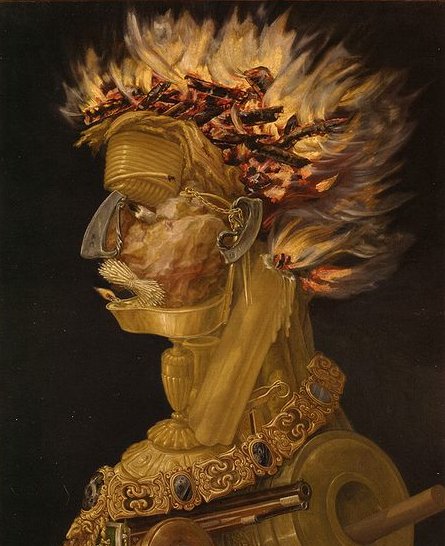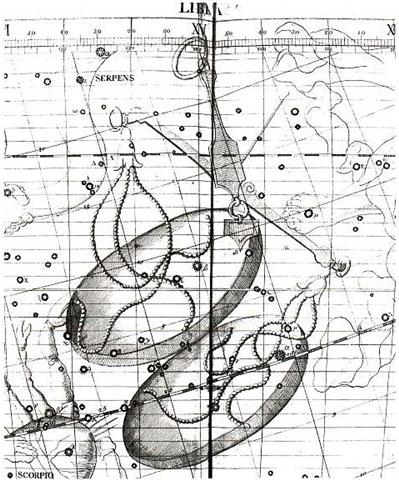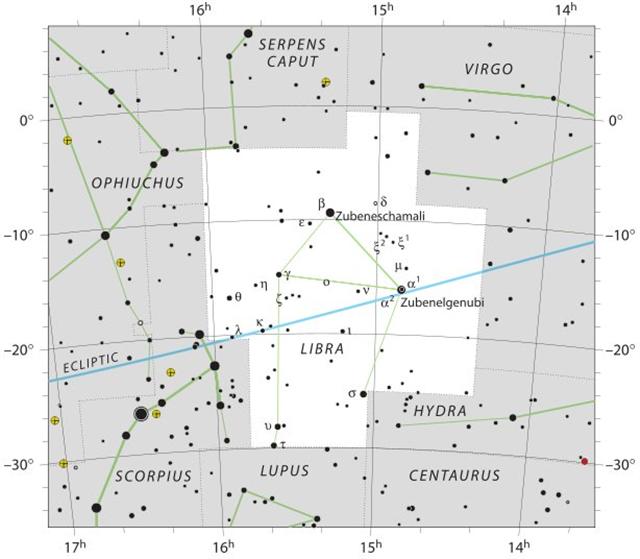312. Presumably the 'stone figure' of Oto Uta referred to the constellation of Cetus, the great fish with paws up on the cape, moving from Sea to Land:
| Uta.
Higher up (from the coast, or from another place); i uta era, further up, up there; ki î te îka i uta, as there are lots of fish on the beach. Vanaga.
1. Inland, landward; paepae ki uta, to strand, to run aground; mouku uta, herbage. 2. To carry; uta mai, to import; hakauta, to give passage. Campbell. |
Similarly the stone figure(s) of Hinariru should refer to some other well known constellation. I guess it referred to Libra at the other side of the sky.
... Raparenga said to Ira, Where is the figure of Hinariru? Ira replied to Raparenga, Up there, on top of that flat rock (papa), at the place where we rode the waves. Raparenga said to Ira, Let's return (there) to see (the figure)! Ira replied, Oh (no), let's leave it alone. When we ride the waves again, the wave will move quickly. If it moves to the right, the eye looks in the right direction and catches a glimpse of Ruhi Hepii. From there the ornament of Ruhi Hepii shines! Then one goes back out again, the wave moves to the left, the eye looks in the left direction, towards Pu. There the ornament of Pu shines forth! One repeats (riding the waves) toward the middle, the eye looks toward Papa O Rae. There the mother-of-pearl necklace of the figure Hinariru shines forth!
Here there were strings of pearls and this was the only Arab station which was plural - the Southern Claw and the Northern Claw possibly alluding to the pair of claws of Cetus.
| AUG 25 (237) |
26 |
27 |
28 (*160) |
 |
 |
 |
 |
| Ga6-17 (157) |
Ga6-18 |
Ga6-19 |
Ga6-20 |
| ρ Lupi (221.0), TOLIMAN (Shoot of the Grapevine) = α Centauri (221.2), π Bootis (221.8), ζ Bootis (221.9) |
31 Bootis (222.0), YANG MUN (South Gate) = α Lupi (222.1), RIJL AL AWWA (Foot of the Barker) = μ Virginis (222.5), ο Bootis (222.9) |
IZAR (Girdle) = ε Bootis (223.0), 109 Virginis, α Apodis (No Feet) (223.3), μ Librae (223.8) |
Al Zubānā-14a (Claws) / Visakha-16 (Forked) / Root-3 (Badger)
ZUBEN ELGENUBI (Southern Claw) = α Librae (224.2), ξ Bootis, ο Lupi (224.5) |
| Oct 28 (301) |
29 (*222) |
30 |
31 |
| °Oct 24 |
25 |
26 (299) |
27 (*220) |
| 'Oct 1 |
2 |
3 (*196) |
4 (277) |
| "Sept 17 (260) |
18 |
19 |
20 (*183) |
| Hora Nui 17 |
18 |
19 |
20 (*1.0 + *182) |
| CLOSE TO THE FULL MOON: |
| FEBR 24 (*340) |
25 |
26 |
27 (58) |
| μ Arietis (39.4), HEAD OF THE FLY = 35 Arietis (39.6), KAFFALJIDHMA (Part of a Hand) = γ Ceti, θ Persei (39.8) |
π Ceti, ο Arietis (40.0), ANGETENAR (Bend in the River) = τ¹ Eridani, μ Ceti (40.2), RIGHT WING = 39 Arietis (40.9) |
Bharani-2 (Yoni) / Stomach-17 (Pheasant)
π Arietis (41.2), MIRAM (Next to the Pleiades) = η Persei (41.3), BHARANI = 41 Arietis (41.4), τ² Eridani, σ Arietis (41.7) |
TA LING (Great Mound) = τ Persei (42.4) |
| April 29 |
30 |
May 1 (121) |
2 (*407) |
| °April 25 |
26 (*36) |
27 |
28 (*403) |
| 'April 2 (92) |
3 (*378) |
4 (*14) |
5 (460) |
| "March 19 (78) |
20 (*364) |
0h |
22 (*42.4 - *41-4 = *1.0) |
| Tarahao 19 |
20 |
21 |
22 |
| AUG 29 |
30 (242) |
31 |
SEPT 1 |
2 (*165) |
3 (246) |
 |
 |
 |
 |
 |
 |
| Ga6-21 |
Ga6-22 |
Ga6-23 |
Ga6-24 (164) |
Ga6-25 |
Ga6-26 |
| KOCHAB = β Ursae Min. (225.0), ξ Librae (225.7) |
KE KWAN (Cavalry Officer) = β Lupi (226.3), KE KWAN = κ Centauri (226.4), ZUBEN ELAKRIBI (Claw of the Scorpion) = δ Librae (226.8), π¹ Oct. (226.9) |
ω Bootis (227.2), NEKKAR (Herdsman) = β Bootis (227.3), σ Librae (227.5), π² Oct. (227.7),
NADLAT (Mean Little Ones) = ψ Bootis (227.8), π Lupi (227.9) |
15h (228.3) ZUBEN HAKRABIM = ν Librae (228.3), λ Lupi (228.9) |
ω Oct. (229.3), ι Librae (229.6), κ Lupi (229.7), ζ Lupi (229.8) |
Al Zubānā-14b (Claws) χ Bootis (230.3), PRINCEPS = δ Bootis (230.6), ZUBEN ELSCHEMALI (Northern Claw) = β Librae (230.8) |
| Nov 1 |
2 |
3 (*227) |
4 |
5 |
6 (310) |
| °Oct 28 (301) |
29 |
30 |
31 (*224) |
°Nov 1 |
2 |
| 'Oct 5 |
6 (*199) |
7 (280) |
8 |
9 |
10 |
| "Sept 21 |
EQUINOX (*185) |
23 (266) |
24 |
25 |
26 |
| Hora Nui 21 |
22 |
23 |
24 |
25 |
26 |
| CLOSE TO THE FULL MOON: |
| FEBR 28 |
MARCH 1 (*345) |
2 |
3 (244 + 183) |
4 (428) |
5 (64) |
| ρ Arietis (43.0), GORGONEA SECUNDA = π Persei (43.5), ACAMAR = θ Eridani (43.6), ε Arietis (43.7), λ Ceti (43.9)
DENEBOLA (β Leonis)
|
MENKAR = α Ceti (44.7) |
3h (45.7)
GORGONEA TERTIA = ρ Persei (45.1), ALGOL = β Persei (45.9)
|
ι Persei (46.1), MISAM (Next to the Pleiades) = κ Persei (46.2), GORGONEA QUARTA) = ω Persei (46.7), BOTEIN (Pair of Bellies) = δ Arietis (46.9) |
ζ Arietis (47.7) |
ZIBAL (Young Ostriches) = ζ Eridani (48.0), κ Ceti (48.9) |
| May 3 |
4 (124) |
5 (490) |
6 |
7 |
8 (*413) |
| °April 29 |
30 (120) |
°May 1 (*41) |
2 |
3 (*408) |
4 |
| 'April 6 |
7 |
8 (*383) |
9 (464) |
10 (100) |
11 |
| "March 23 |
24 |
JULIAN EQUINOX |
26 (450) |
27 (86) |
28 (*372) |
| Tarahao 23 |
24 |
25 |
26 |
27 |
28 |
Close to the Full Moon in AUGUST 31 was Algol and in SEPTEMBER 1 the Sun had reached Zuben Hakrabim (ν), in the center between Zuben Elakribi (δ) and Zuben Elschemali (β).
At the time of Bharani and south of the equator Zuben Elakribi (δ) marked spring equinox preceded 4 days earlier by the Foot of the Barker. Here Hevelius has right ascension increasing from right to left - as it would appear when looking up towards the sky dome - whereas he has drawn the face of Cetus looking towards the right - as it would appear from a view point outside the celestial sphere:

... μ [Virginis], a 3.9 magnitude, was Al Achsasi's Rijl al Άwwā', the Foot of the Barker. It has been included with δ Librae in the Akkadian lunar asterism Mulu Izi, a title also applied to ε; the Sogdian Fasarwa, and the Khorasmian Sara-fsariwa, both signifying the 'One next to the Leader' - i.e. next to the lunar asterism ι, κ, and λ ...

... δ, Variable, 5 to 6.2, white, seems to have been associated with μ Virginis in the Akkadian lunar asterism Mulu-izi, the Man on Fire, connected with the star-god Laterak; and in the Sogdian Fasariva and the Khorasmian Sara-fasariva, both titles signifying the One next to the Leader, i.e. preceding moon station, ι, κ, and λ Virginis. It is a variable of the Algol type, discovered by Schmidt in 1859, with a period of nearly two days and eight hours, the light oscillation occupying twelve hours ...

|











